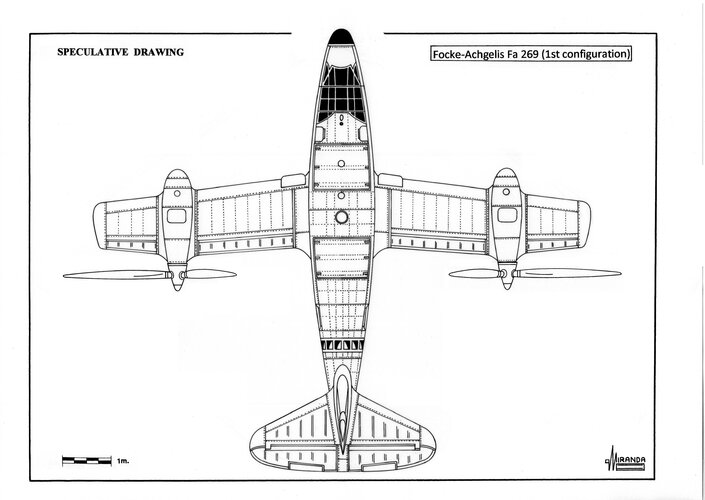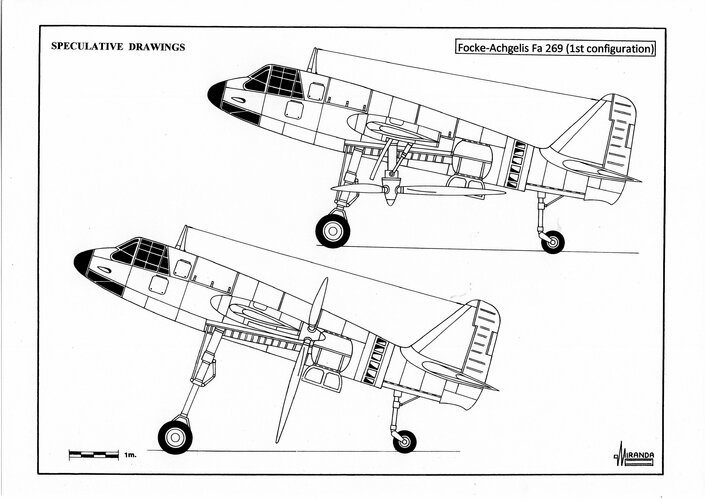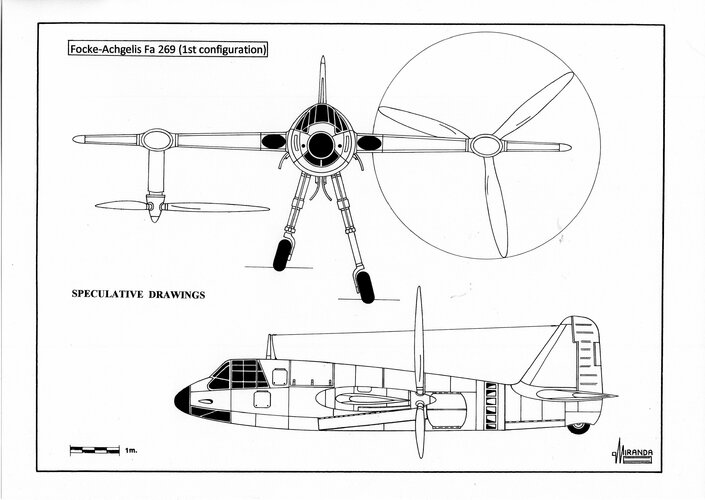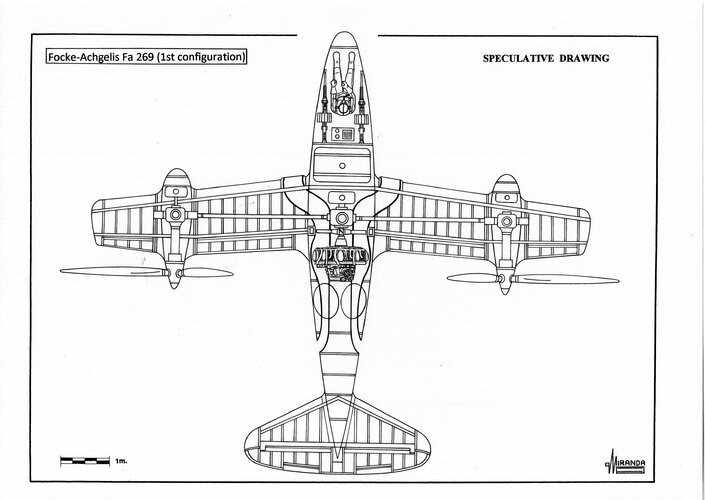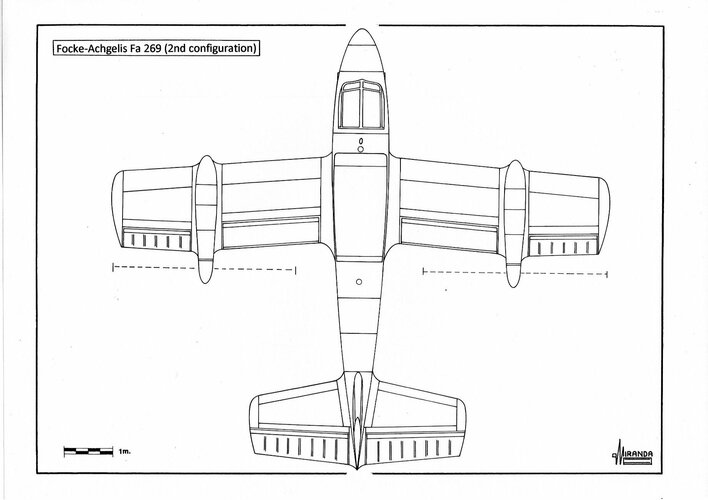You are using an out of date browser. It may not display this or other websites correctly.
You should upgrade or use an alternative browser.
You should upgrade or use an alternative browser.
Focke-Achgelis Fa 269 (First configuration)
- Thread starter Justo Miranda
- Start date
Ivan Culjak
ACCESS: Confidential
- Joined
- 11 September 2021
- Messages
- 53
- Reaction score
- 53
Hi,
Do you have, by chance, something more on Focke post war convertiplane project based on Fa 269, in Brasil, with CTA. There are some pdf on other SP forums, but in Portuguese, some info on Focke Wikipedia page, too. But it was quite ambitious project, made some take offs, probably on the test rig..
One link, just found
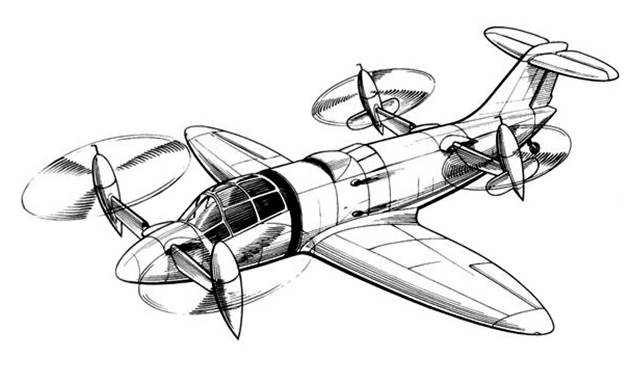
 oldmachinepress.com
oldmachinepress.com
Do you have, by chance, something more on Focke post war convertiplane project based on Fa 269, in Brasil, with CTA. There are some pdf on other SP forums, but in Portuguese, some info on Focke Wikipedia page, too. But it was quite ambitious project, made some take offs, probably on the test rig..
One link, just found
CTA / ITA Heliconair HC-I Convertiplano
Designed by Germans and built in Brazil using an American engine, British wings, and Swedish propellers, the CTA/ITA Heliconair Convertiplano tiltrotor VTOL aircraft was unique in many ways.
Last edited:
Hi,
Do you have, by chance, something more on Focke post war convertiplane project based on Fa 269, in Brasil, with CTA. There are some pdf on other SP forums, but in Portuguese, some info on Focke Wikipedia page, too. But it was quite ambitious project, made some take offs, probably on the test rig..
One link, just found

CTA / ITA Heliconair HC-I Convertiplano
Designed by Germans and built in Brazil using an American engine, British wings, and Swedish propellers, the CTA/ITA Heliconair Convertiplano tiltrotor VTOL aircraft was unique in many ways.oldmachinepress.com
I have a translation of the article published in Aero Magazine
Convertiplano, the forgotten pioneer
Little known, the origin of the current Brazilian aerospace industry was based on the program of an airplane capable of landing and taking off like a helicopter
Earlier this year, Agusta Westland, one of the world's largest helicopter manufacturers, released a statement confirming the completion of "all regulatory and legal steps for the acquisition of the 609 Program." And it scheduled for 2016 the delivery of the first serial examples of this aircraft. What few people know is that this project was born in Brazil, in São José dos Campos, in the interior of São Paulo, in 1952, in a program directed by the German Hendrich Focke. The engineer started the work in Brazil, then went to the United States and, finally, ended up working for Bell Helicopters, which recently sold the plans and prototypes to the European Agusta Westland. More than half a century later, the project is close to reality, but its pioneers are still forgotten. Even here in Brazil. The aircraft in question is the Convertiplano, the world's first VTOL (Vertical Take-Off and Landing ) device, which was developed at ITA (Technological Institute of Aeronautics) - at the time, called the Technical Institute of Aeronautics.
The Convertiplano Program envisaged the construction of an aircraft capable of ascending and descending vertically in small areas, and capable of flying at the speed of a normal airplane
Born in Germany in 1895, Hendrich Focke grew up with aviation. He graduated as an engineer and chose to execute aircraft projects. In January 1924, he founded Focke-Wulf Flugzeugbau GmbH together with George Wulf, who would later also become famous as a designer. But both had strong personalities and the partnership was broken. Focke opted for the development of rotary-wing aircraft, and Wulf specialized in fighter aircraft designs. Then, in 1938, Focke-Achhelis emerged. By the end of World War II, the company had built a series of small military helicopters for the Luftwaffe. After the conflict, Focke became unemployed. Without resources, he went to work in the Netherlands. And it was there that Brazilians discovered it.
YOUNG ENGINEERS FROM ITANIn Europe, while the old designer was trying to develop rotary-wing aircraft, in Brazil, a group of aeronautical officers was working to establish in São José dos Campos the bases of what would later be the CTA (Aerospace Technical Center). It was not easy, since at that time few saw the need to train aeronautical engineers in the country. But the pioneering spirit ended up prevailing and, in January 1950, ITA was inaugurated, the first of the CTA institutes. It was one of these precursors, later Brigadier Casimiro Montenegro Filho, who "discovered" Focke in the Netherlands and suggested that he be hired to teach at the new institute.
Focke came to Brazil the following year, visited ITA and liked it. In 1952, he returned to stay. It was agreed that, in addition to teaching, he would direct a training program for young national engineers in the development of vertical takeoff aircraft. In a country like Brazil, then with few airstrips, these characteristics were very useful. And so the Convertiplano Program was born, an aircraft capable of going up and down in small areas like a helicopter, and capable of flying at the speed of a normal airplane.
#Q#
For the then young ITA, Focke's visit was vital: it motivated the students, attracted the government's attention to the value of aeronautical research and brought to the country experience in the development and testing of new devices. More than that: he convinced the CTA board of the opportunity to hire other European aeronautical engineers who were unemployed with the end of World War II. It was at this time that numerous professionals arrived, who ended up putting down roots in Brazil, such as Hans Swoboda. Later, many of them would work at Embraer, whose founders were his students at ITA.
THE PROGRAM ADVANCES
At the end of 1952, the group included more than 40 people, including Brazilians and foreign contractors, and occupied Hangar 40 of the CTA. It was agreed that a prototype would be built to evaluate the performance of the postponed machine and the funds would be released for the execution of the project. Working in a research center that was still incipient, the group had to resort to a lot of improvisation. The CTA at that time was still far from being the advanced laboratory complex it is today, but enthusiasm was high and an English Spitfire fighter, from the RAF (Royal Air Force), was acquired for use as a laboratory aircraft.
Professor Focke wanted to acquire an English Double Mamba turbine, which, in addition to being compact, was vibration-free and strong enough for the desired project. But, obviously, London did not want one of its most advanced engines to be used in a "suspicious project", and the sale was refused. Therefore, the solution was to acquire a North American radial engine of 2,200 HP, used in the Constellation commercial aircraft. It had the necessary power, but it was large and heavy, which required extra work to modify the fuselage of the Spitfire, whose landing gear was similarly reinforced. In 1953, the device was ready, while another group worked on the construction of the transmission system ordered by the German BMW.
#Q# A test bench was built in São José dos Campos to test this engine-transmission assembly and solve the problems of vibration and lubrication. Thus, at the end of 1953, the whole was working satisfactorily. It included a central engine, placed behind the cockpit of the plane, which transmitted power to four moving rotors at the ends of four drive arms, two at the front and two behind the fuselage. | |||
| In 1953, test benches for testing engine-transmission assembly included a central engine, placed behind the airplane cabin, which transmitted power to four moving rotors at the ends of four drive arms |
At Bell, the VTOL program resulted in the design of the civilian Model 609, which promised such advanced performance that the Brazilian company Líder was the first to order. But there too, the development of aircraft of this type ran into several technical obstacles. So much so that Bell gave up on it after building and beginning trials of two prototypes. And that's exactly the program that was sold to Agusta Westland recently.
Focke's team laid the foundations of the research programs that made ITA famous
In Brazil, the balance was also positive. Focke's team trained a generation of good engineers and laid the foundations of the research programs that made ITA famous - which years later resulted in the twin-engine Bandeirante and Embraer, created to manufacture it in series. From the group that developed the Convertiplano was the experience, which was then used to develop a family of light helicopters such as the Beija-Flor and the Abelha, effectively built and tested.
It was practically the Convertiplano program that started the now thriving Brazilian aeronautical industry.
By: Roberto Pereira De Andrade Published in 22/05/2012, at 07:09 - Updated in 27/07/2013, at 18:45
- In the morning of October 7, 1939, a concentration of British warships were located in the North Sea by a Heinkel He 111 H-6 reconnaissance aircraft of the KG 26 photographic unit.
This powerful naval group was attacked by 127 Heinkel He 111 and 21 Junkers Ju 88 bombers from the X Fliegerkorps.
The Kriegsmarine staff was also ordered to co-ordinate an aerial attack of its naval air arm. Five Heinkel He 59 torpedo-bomber floatplanes and 23 Dornier Do 18 reconnaissance flying boats were deployed but, despite hours of searching, they failed to contact the enemy and no concerted Luftwaffe attack was mounted.
On October 22, a new Luftwaffe-Kriegsmarine joint action was attempted against convoy FN24 from Methil to Orfordness.
The attack involved three Ju 88s of the 1.KG 30 and ten Heinkel He 115 floatplanes of the 1./Kü.Fl.Gr.406, but it turned out that the Ju 88s were faster and reached the convoy much earlier than the He 115, alerting the British defenses. When the naval planes began the attack, they were intercepted by Hawker Hurricane and Supermarine Spitfire fighters of the 46th and 72nd RAF squadrons that managed to shoot down four floatplanes and damaged others.
The disaster was used politically to the benefit of the Luftwaffe. In November 15, Reichsmarshall Hermann Göring ordered the reduction of the Küstenflieger units to just nine long-range reconnaissance and nine multipurpose Staffeln.
By that time, the Graf Zeppelin aircraft carrier was 85 per cent complete and the first carrier-borne wing Trägergruppe 186 (equipped with Junkers Ju 87C and Messerschmitt Bf 109 T-1) was formed at Kiel Holtenau.
Halting all work on the aircraft carrier was proposed on April 28, 1940, during a naval conference. In July, the ship was towed from Kiel to Gdnya and its guns and aircraft were transferred to Norway.
After the loss of its air arm, the Kriegsmarine was forced to operate under the protection of the Luftwaffe in an area comprising most of the Baltic Sea and the Norwegian coast, remaining within the range of the Messerschmitt Bf 110 heavy fighters.
The strategic situation changed in 1941 making it necessary for the German fleet to enter the Atlantic Ocean and raid Allied shipping from North America to Great Britain.
In May, the Bismarck battleship, along with the heavy cruiser Prinz Eugen, were detected off Scandinavia and dozens of Royal Navy combat units were deployed to block their route.
Both German ships were detected again successively by one Short Sunderland from No. 201 Sqn, one Lockheed Hudson from No. 269 Sqn and two Consolidated Catalina from Sqns. Nos. 209 and 240.
After being located by reconnaissance aircraft, the German naval formation was attacked by a squadron of Fairey Swordfish torpedo-bombers from the aircraft carrier Ark Royal.
In the rough sea the German anti-aircraft guns were unable to break up the attack and a torpedo managed to disable the steering system of the Bismarck. The damage delayed the ship enough for the slower British battleships to catch up and sink her.
None of this would have happened if the German naval formation had included an aircraft carrier. The slow biplanes of the Ark Royal would not have stood a chance against the formidable Messerschmitt interceptors, which could also have scared away the reconnaissance aircraft. But all available Bf 109 T-1 units, specially designed for carrier use, were used by the I./JG 77 as night fighters in Norway.
The efficiency demonstrated by British aircraft made it necessary to protect the few German warships that had survived from air strikes during the conquest of Norway. In December 1941, Admiral Erich Raeder, anxious to secure air protection for the Kriegsmarine’s heavy surface units, proposed Hitler that Graf Zeppelin could be finished in about a year and that the carrier could begin combat operations in June 1943.
By that time, it was considered that sufficient experience had been gained in the field of helicopters. A design study order was issued to Focke-Achgelis G.m.b. H, calling for a local defense fighter with extreme vertical-take-off-and-landing (VTOL) and hovering capabilities, able to operate from the rear decks of the warships.
Early in 1942 the Delmenhorts design team proposed the Fa 269, a highly innovative project combining the VTOL capabilities of the helicopter with the speed of a fixed-wing aircraft.
The mid-wing Fa 269 had a conventional fuselage and tail surfaces, wing mounted pusher rotors and one radial engine buried in the fuselage, behind the cockpit.
The main drawback of this configuration was the cooling of the engine. It was necessary to design two wing mounted air scoops, two refrigeration air ducts and one forced cooling fan installed in front of the engine. The air circulating through the inner fuselage was expelled, together with the engine exhaust gases, through one annular nozzle located at the rear.
The power plant selected was a BMW 132, a very safe engine that was already being used in several types of naval aircraft such as the Heinkel He 115 and the Arado Ar 196.
Engine power was transferred to both tiltrotors by means of transverse drive shafts housed into the wings and three synchronized gearboxes.
The three-bladed rotors would have pivoted downward and forward through about of 85-degrees using the swiveling system patented in 1921 by Claudius Dornier.
Both rotors generated a great deal of torque. To compensate this effect, the starboard propeller rotated in clockwise direction and the port propeller rotated counterclockwise, producing symmetric slipstream effect over the wing areas behind the propellers and also giving better airflow over the center portion of the wing.
During the transition the rotors forced air at high speed over the wings, keeping the wing lifting at low speeds and reducing the stall speed. This helped support aircraft weight.
Trailing edge flaps increased lift at partial tilt angles and pusher configuration provided downward thrust and enhance lift.
The length of the telescopic legs of the main landing gear could be varied from 2.06 m and 12-degrees incidence in VTOL mode, to 2.62 m and 18-degrees of incidence so that the Fa 269 could land as a conventional aircraft in case of emergency.
A considerable work was undertaken in the development of gearboxes and power drive shafts, using technologies tested in the Dornier flying boats Do 14 and Do 26.
Wind tunnel models were used to study transition problems and rotor motion at speeds between zero and six hundred kilometers per hour.
The full-scale mock-up was inspected early in 1942.
It was expected to start serial production of the combat version in 1943, but the entire project was delayed after the destruction of the Focke-Achgelis factory during the Allied bombing of Hoykenkamp on June 4, 1942.
When the Allies began using Consolidated Liberator long-range bombers in the Battle of the Atlantic, the decision was made to replace the 20-mm guns with 30-mm guns. To compensate for the increase in weight the engine also had to be replaced by a BMW 801.
The design work continued until the end of the year, but all development was shelved by late January 1943 when Hitler ordered all its larger warships to be taken out of service and scrapped.
Focke-Achgelis Fa 269 (1st configuration) technical data
Wingspan: 10 m, length. 8.93 m, height (VTOL mode): 4.27 m, height (emergency landing mode): 4.83 m, estimated wing area: 10.77 sq. m, rotor diameter: 4.6 m, estimated max weight: 4,000-4,200 kg, estimated max speed: 570-600 km/h, power plant: one BMW 132 K nine-cylinder, air-cooled, radial engine rated at 947 hp, armament: two fuselage mounted 20-mm MG FF/M cannons, electronics: FuG 17 R/T, FuG 25 IFF, FuG 101 radio-altimeter, vertical speed indicator, turn and bank indicator, RPM rotor indicator and rotor pitch indicator.
Focke-Achgelis Fa 269 (2nd configuration) technical data
Wingspan: 10 m, length. 8.9 m, height: 3.2 m, rotor diameter: 3.76 m, estimated max speed: 570 km/h, power plant: one BMW 801 D-2 fourteen-cylinder, air-cooled, radial engine rated at 1,700 hp (2,100 hp with MW 50 boost), armament: two fuselage mounted 30-mm MK 108 cannons.
On February 10, 1956, the Fa 269 concept was revived by the Bundesministerium für Verteidigung, the Dornier Flugzeugwerke design team and the Deutsche Versuchsanstalt für Luftfahrt laboratory.
Two examples of the Dornier Do 27 light transport planes were modified with tilting propellers and the first prototype (Do 29 V1) was flown on December 21, 1958.
During the flight testing the aircraft proved to be a good short-field performance with take-off in 80 ft, landing in 50 ft and 24 km/h stalling speed, but the Hartzell propellers were not rotated further than 60-degrees instead of the 90-degrees of its nominal capability. In this configuration it had a high resistance to forward motion and a steep angle of approach. The propellers were replaced by Ratier props, but problems remained at high angles of attack and the project was cancelled during the summer of 1963.
This powerful naval group was attacked by 127 Heinkel He 111 and 21 Junkers Ju 88 bombers from the X Fliegerkorps.
The Kriegsmarine staff was also ordered to co-ordinate an aerial attack of its naval air arm. Five Heinkel He 59 torpedo-bomber floatplanes and 23 Dornier Do 18 reconnaissance flying boats were deployed but, despite hours of searching, they failed to contact the enemy and no concerted Luftwaffe attack was mounted.
On October 22, a new Luftwaffe-Kriegsmarine joint action was attempted against convoy FN24 from Methil to Orfordness.
The attack involved three Ju 88s of the 1.KG 30 and ten Heinkel He 115 floatplanes of the 1./Kü.Fl.Gr.406, but it turned out that the Ju 88s were faster and reached the convoy much earlier than the He 115, alerting the British defenses. When the naval planes began the attack, they were intercepted by Hawker Hurricane and Supermarine Spitfire fighters of the 46th and 72nd RAF squadrons that managed to shoot down four floatplanes and damaged others.
The disaster was used politically to the benefit of the Luftwaffe. In November 15, Reichsmarshall Hermann Göring ordered the reduction of the Küstenflieger units to just nine long-range reconnaissance and nine multipurpose Staffeln.
By that time, the Graf Zeppelin aircraft carrier was 85 per cent complete and the first carrier-borne wing Trägergruppe 186 (equipped with Junkers Ju 87C and Messerschmitt Bf 109 T-1) was formed at Kiel Holtenau.
Halting all work on the aircraft carrier was proposed on April 28, 1940, during a naval conference. In July, the ship was towed from Kiel to Gdnya and its guns and aircraft were transferred to Norway.
After the loss of its air arm, the Kriegsmarine was forced to operate under the protection of the Luftwaffe in an area comprising most of the Baltic Sea and the Norwegian coast, remaining within the range of the Messerschmitt Bf 110 heavy fighters.
The strategic situation changed in 1941 making it necessary for the German fleet to enter the Atlantic Ocean and raid Allied shipping from North America to Great Britain.
In May, the Bismarck battleship, along with the heavy cruiser Prinz Eugen, were detected off Scandinavia and dozens of Royal Navy combat units were deployed to block their route.
Both German ships were detected again successively by one Short Sunderland from No. 201 Sqn, one Lockheed Hudson from No. 269 Sqn and two Consolidated Catalina from Sqns. Nos. 209 and 240.
After being located by reconnaissance aircraft, the German naval formation was attacked by a squadron of Fairey Swordfish torpedo-bombers from the aircraft carrier Ark Royal.
In the rough sea the German anti-aircraft guns were unable to break up the attack and a torpedo managed to disable the steering system of the Bismarck. The damage delayed the ship enough for the slower British battleships to catch up and sink her.
None of this would have happened if the German naval formation had included an aircraft carrier. The slow biplanes of the Ark Royal would not have stood a chance against the formidable Messerschmitt interceptors, which could also have scared away the reconnaissance aircraft. But all available Bf 109 T-1 units, specially designed for carrier use, were used by the I./JG 77 as night fighters in Norway.
The efficiency demonstrated by British aircraft made it necessary to protect the few German warships that had survived from air strikes during the conquest of Norway. In December 1941, Admiral Erich Raeder, anxious to secure air protection for the Kriegsmarine’s heavy surface units, proposed Hitler that Graf Zeppelin could be finished in about a year and that the carrier could begin combat operations in June 1943.
By that time, it was considered that sufficient experience had been gained in the field of helicopters. A design study order was issued to Focke-Achgelis G.m.b. H, calling for a local defense fighter with extreme vertical-take-off-and-landing (VTOL) and hovering capabilities, able to operate from the rear decks of the warships.
Early in 1942 the Delmenhorts design team proposed the Fa 269, a highly innovative project combining the VTOL capabilities of the helicopter with the speed of a fixed-wing aircraft.
The mid-wing Fa 269 had a conventional fuselage and tail surfaces, wing mounted pusher rotors and one radial engine buried in the fuselage, behind the cockpit.
The main drawback of this configuration was the cooling of the engine. It was necessary to design two wing mounted air scoops, two refrigeration air ducts and one forced cooling fan installed in front of the engine. The air circulating through the inner fuselage was expelled, together with the engine exhaust gases, through one annular nozzle located at the rear.
The power plant selected was a BMW 132, a very safe engine that was already being used in several types of naval aircraft such as the Heinkel He 115 and the Arado Ar 196.
Engine power was transferred to both tiltrotors by means of transverse drive shafts housed into the wings and three synchronized gearboxes.
The three-bladed rotors would have pivoted downward and forward through about of 85-degrees using the swiveling system patented in 1921 by Claudius Dornier.
Both rotors generated a great deal of torque. To compensate this effect, the starboard propeller rotated in clockwise direction and the port propeller rotated counterclockwise, producing symmetric slipstream effect over the wing areas behind the propellers and also giving better airflow over the center portion of the wing.
During the transition the rotors forced air at high speed over the wings, keeping the wing lifting at low speeds and reducing the stall speed. This helped support aircraft weight.
Trailing edge flaps increased lift at partial tilt angles and pusher configuration provided downward thrust and enhance lift.
The length of the telescopic legs of the main landing gear could be varied from 2.06 m and 12-degrees incidence in VTOL mode, to 2.62 m and 18-degrees of incidence so that the Fa 269 could land as a conventional aircraft in case of emergency.
A considerable work was undertaken in the development of gearboxes and power drive shafts, using technologies tested in the Dornier flying boats Do 14 and Do 26.
Wind tunnel models were used to study transition problems and rotor motion at speeds between zero and six hundred kilometers per hour.
The full-scale mock-up was inspected early in 1942.
It was expected to start serial production of the combat version in 1943, but the entire project was delayed after the destruction of the Focke-Achgelis factory during the Allied bombing of Hoykenkamp on June 4, 1942.
When the Allies began using Consolidated Liberator long-range bombers in the Battle of the Atlantic, the decision was made to replace the 20-mm guns with 30-mm guns. To compensate for the increase in weight the engine also had to be replaced by a BMW 801.
The design work continued until the end of the year, but all development was shelved by late January 1943 when Hitler ordered all its larger warships to be taken out of service and scrapped.
Focke-Achgelis Fa 269 (1st configuration) technical data
Wingspan: 10 m, length. 8.93 m, height (VTOL mode): 4.27 m, height (emergency landing mode): 4.83 m, estimated wing area: 10.77 sq. m, rotor diameter: 4.6 m, estimated max weight: 4,000-4,200 kg, estimated max speed: 570-600 km/h, power plant: one BMW 132 K nine-cylinder, air-cooled, radial engine rated at 947 hp, armament: two fuselage mounted 20-mm MG FF/M cannons, electronics: FuG 17 R/T, FuG 25 IFF, FuG 101 radio-altimeter, vertical speed indicator, turn and bank indicator, RPM rotor indicator and rotor pitch indicator.
Focke-Achgelis Fa 269 (2nd configuration) technical data
Wingspan: 10 m, length. 8.9 m, height: 3.2 m, rotor diameter: 3.76 m, estimated max speed: 570 km/h, power plant: one BMW 801 D-2 fourteen-cylinder, air-cooled, radial engine rated at 1,700 hp (2,100 hp with MW 50 boost), armament: two fuselage mounted 30-mm MK 108 cannons.
On February 10, 1956, the Fa 269 concept was revived by the Bundesministerium für Verteidigung, the Dornier Flugzeugwerke design team and the Deutsche Versuchsanstalt für Luftfahrt laboratory.
Two examples of the Dornier Do 27 light transport planes were modified with tilting propellers and the first prototype (Do 29 V1) was flown on December 21, 1958.
During the flight testing the aircraft proved to be a good short-field performance with take-off in 80 ft, landing in 50 ft and 24 km/h stalling speed, but the Hartzell propellers were not rotated further than 60-degrees instead of the 90-degrees of its nominal capability. In this configuration it had a high resistance to forward motion and a steep angle of approach. The propellers were replaced by Ratier props, but problems remained at high angles of attack and the project was cancelled during the summer of 1963.

